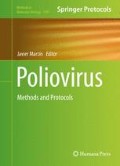Abstract
Replication of viruses leads to emergence of mutations and their content in viral populations can increase by selection depending on growth conditions. Some of these mutations have deleterious effect on vaccine safety, such as neurovirulent reversions in the 5′-UTR of attenuated Sabin strains of poliovirus. Their content in vaccine batches must be tightly controlled during vaccine manufacture to ensure safety of the product. This chapter describes a quantitative molecular procedure called mutant analysis by PCR and restriction enzyme cleavage (MAPREC) that is used to monitor content of neurovirulent revertants in Oral Polio Vaccine (OPV). The method can be used for quantitative analysis of any other mutation in a viral population.
Access this chapter
Tax calculation will be finalised at checkout
Purchases are for personal use only
References
WHO (2012) Recommendations to assure the quality, safety and efficacy of live attenuated poliomyelitis vaccine (oral). WHO technical report series, vol 904. World Health Organization, Geneva, Switzerland. pp 1–87
Evans DM et al (1985) Increased neurovirulence associated with a single nucleotide change in a noncoding region of the Sabin type 3 poliovaccine genome. Nature 314(6011):548–550
Cann AJ et al (1984) Reversion to neurovirulence of the live-attenuated Sabin type 3 oral poliovirus vaccine. Nucleic Acids Res 12(20):7787–7792
Macadam AJ et al (1991) The 5′ noncoding region of the type 2 poliovirus vaccine strain contains determinants of attenuation and temperature sensitivity. Virology 181(2):451–458
Christodoulou C et al (1990) Mapping of mutations associated with neurovirulence in monkeys infected with Sabin 1 poliovirus revertants selected at high temperature. J Virol 64(10):4922–4929
Chumakov K et al (1992) RNA sequence variability in attenuated poliovirus. In: Brown F, Chanock R, Ginsberg H, Lerner R (eds) Vaccines 92. Cold Spring Harbor Laboratory Press, Cold Spring Harbor, NY, pp 331–335
Chumakov K et al (1993) Assessment of the viral RNA sequence heterogeneity for control of OPV neurovirulence. Dev Biol Standard 78:79–89, discussion 88–79
Punia P, Cane P, Teo CG, Saunders N (2004) Quantitation of hepatitis B lamivudine resistant mutants by real-time amplification refractory mutation system PCR. J Hepatol 40(6):986–992
Troy SB et al (2011) Use of a novel real-time PCR assay to detect oral polio vaccine shedding and reversion in stool and sewage samples after a Mexican national immunization day. J Clin Microbiol 49(5):1777–1783
Laassri M, Bidzhieva B, Speicher J, Pletnev AG, Chumakov K (2011) Microarray hybridization for assessment of the genetic stability of chimeric West Nile/dengue 4 virus. J Med Virol 83(5):910–920
Amexis G et al (2001) Quantitative mutant analysis of viral quasispecies by chip-based matrix-assisted laser desorption/ionization time-of-flight mass spectrometry. Proc Natl Acad Sci U S A 98(21):12097–12102
Proudnikov D et al (2000) Analysis of mutations in oral poliovirus vaccine by hybridization with generic oligonucleotide microchips. Biologicals 28(2):57–66
Bidzhieva B, Laassri M, Chumakov K (2011) MAPREC assay for quantitation of mutants in a recombinant flavivirus vaccine strain using near-infrared fluorescent dyes. J Virol Methods 175(1):14–19
Chumakov KM (1995) Reverse transcriptase can inhibit PCR and stimulate primer-dimer formation. PCR Methods Appl 4:62–64
Author information
Authors and Affiliations
Corresponding author
Editor information
Editors and Affiliations
Rights and permissions
Copyright information
© 2016 Springer Science+Business Media New York
About this protocol
Cite this protocol
Chumakov, K.M. (2016). Methods to Monitor Molecular Consistency of Oral Polio Vaccine. In: Martín, J. (eds) Poliovirus. Methods in Molecular Biology, vol 1387. Humana Press, New York, NY. https://doi.org/10.1007/978-1-4939-3292-4_14
Download citation
DOI: https://doi.org/10.1007/978-1-4939-3292-4_14
Publisher Name: Humana Press, New York, NY
Print ISBN: 978-1-4939-3291-7
Online ISBN: 978-1-4939-3292-4
eBook Packages: Springer Protocols

